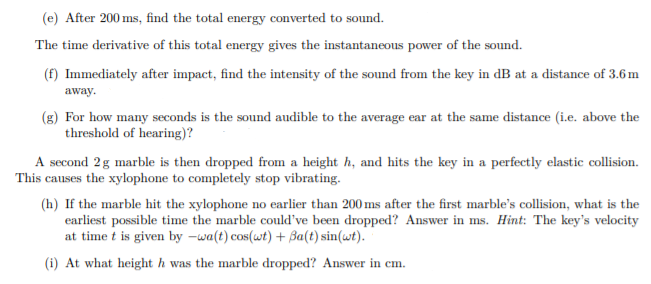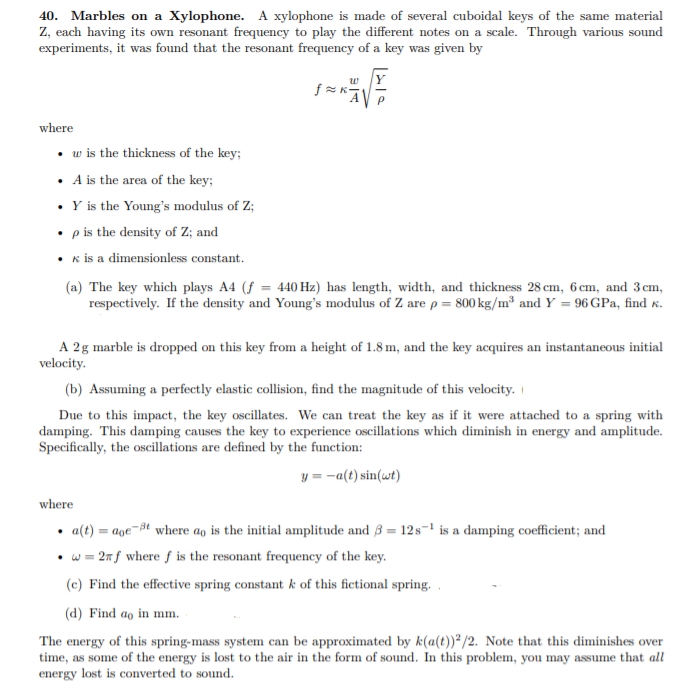(e) After 200 ms, find the total energy converted to sound. The time derivative of this total energy gives the instantaneous power of the sound. (f) Immediately after impact, find the intensity of the sound from the key in dB at a distance of 3.6m away. (g) For how many seconds is the sound audible to the average ear at the same distance (i.e. above the threshold of hearing)? A second 2g marble is then dropped from a height h, and hits the key in a perfectly elastic collision. This causes the xylophone to completely stop vibrating. (h) If the marble hit the xylophone no earlier than 200 ms after the first marble's collision, what is the earliest possible time the marble could've been dropped? Answer in ms. Hint: The key's velocity at time t is given by –wa(t) cos(wt) + Ba(t) sin(wt). (i) At what height h was the marble dropped? Answer in cm. 40. Marbles on a Xylophone. A xylophone is made of several cuboidal keys of the same material Z, each having its own resonant frequency to play the different notes on a scale. Through various sound experiments, it was found that the resonant frequency of a key was given by w lY where • w is the thickness of the key; • A is the area of the key; • Y is the Young's modulus of Z; • p is the density of Z; and • K is a dimensionless constant. (a) The key which plays A4 (f = 440 Hz) has length, width, and thickness 28 cm, 6 cm, and 3cm, respectively. If the density and Young's modulus of Z are p = 800 kg/m³ and Y = 96 GPa, find x. A 2g marble is dropped on this key from a height of 1.8 m, and the key acquires an instantaneous initial velocity. (b) Assuming a perfectly elastic collision, find the magnitude of this velocity. I Due to this impact, the key oscillates. We can treat the key as if it were attached to a spring with damping. This damping causes the key to experience oscillations which diminish in energy and amplitude. Specifically, the oscillations are defined by the function: y = -a(t) sin(wt) where • a(t) = age¬t where ao is the initial amplitude and 3 = 12s-l is a damping coefficient; and w = 27f where f is the resonant frequency of the key. (c) Find the effective spring constant k of this fictional spring.. (d) Find ao in mm. The energy of this spring-mass system can be approximated by k(a(t))²/2. Note that this diminishes over time, as some of the energy is lost to the air in the form of sound. In this problem, you may assume that all energy lost is converted to sound.
(e) After 200 ms, find the total energy converted to sound. The time derivative of this total energy gives the instantaneous power of the sound. (f) Immediately after impact, find the intensity of the sound from the key in dB at a distance of 3.6m away. (g) For how many seconds is the sound audible to the average ear at the same distance (i.e. above the threshold of hearing)? A second 2g marble is then dropped from a height h, and hits the key in a perfectly elastic collision. This causes the xylophone to completely stop vibrating. (h) If the marble hit the xylophone no earlier than 200 ms after the first marble's collision, what is the earliest possible time the marble could've been dropped? Answer in ms. Hint: The key's velocity at time t is given by –wa(t) cos(wt) + Ba(t) sin(wt). (i) At what height h was the marble dropped? Answer in cm. 40. Marbles on a Xylophone. A xylophone is made of several cuboidal keys of the same material Z, each having its own resonant frequency to play the different notes on a scale. Through various sound experiments, it was found that the resonant frequency of a key was given by w lY where • w is the thickness of the key; • A is the area of the key; • Y is the Young's modulus of Z; • p is the density of Z; and • K is a dimensionless constant. (a) The key which plays A4 (f = 440 Hz) has length, width, and thickness 28 cm, 6 cm, and 3cm, respectively. If the density and Young's modulus of Z are p = 800 kg/m³ and Y = 96 GPa, find x. A 2g marble is dropped on this key from a height of 1.8 m, and the key acquires an instantaneous initial velocity. (b) Assuming a perfectly elastic collision, find the magnitude of this velocity. I Due to this impact, the key oscillates. We can treat the key as if it were attached to a spring with damping. This damping causes the key to experience oscillations which diminish in energy and amplitude. Specifically, the oscillations are defined by the function: y = -a(t) sin(wt) where • a(t) = age¬t where ao is the initial amplitude and 3 = 12s-l is a damping coefficient; and w = 27f where f is the resonant frequency of the key. (c) Find the effective spring constant k of this fictional spring.. (d) Find ao in mm. The energy of this spring-mass system can be approximated by k(a(t))²/2. Note that this diminishes over time, as some of the energy is lost to the air in the form of sound. In this problem, you may assume that all energy lost is converted to sound.
Principles of Heat Transfer (Activate Learning with these NEW titles from Engineering!)
8th Edition
ISBN:9781305387102
Author:Kreith, Frank; Manglik, Raj M.
Publisher:Kreith, Frank; Manglik, Raj M.
Chapter5: Analysis Of Convection Heat Transfer
Section: Chapter Questions
Problem 5.2P: 5.2 Evaluate the Prandtl number from the following data: , .
Related questions
Question

Transcribed Image Text:(e) After 200 ms, find the total energy converted to sound.
The time derivative of this total energy gives the instantaneous power of the sound.
(f) Immediately after impact, find the intensity of the sound from the key in dB at a distance of 3.6m
away.
(g) For how many seconds is the sound audible to the average ear at the same distance (i.e. above the
threshold of hearing)?
A second 2g marble is then dropped from a height h, and hits the key in a perfectly elastic collision.
This causes the xylophone to completely stop vibrating.
(h) If the marble hit the xylophone no earlier than 200 ms after the first marble's collision, what is the
earliest possible time the marble could've been dropped? Answer in ms. Hint: The key's velocity
at time t is given by –wa(t) cos(wt) + Ba(t) sin(wt).
(i) At what height h was the marble dropped? Answer in cm.

Transcribed Image Text:40. Marbles on a Xylophone. A xylophone is made of several cuboidal keys of the same material
Z, each having its own resonant frequency to play the different notes on a scale. Through various sound
experiments, it was found that the resonant frequency of a key was given by
w lY
where
• w is the thickness of the key;
• A is the area of the key;
• Y is the Young's modulus of Z;
• p is the density of Z; and
• K is a dimensionless constant.
(a) The key which plays A4 (f = 440 Hz) has length, width, and thickness 28 cm, 6 cm, and 3cm,
respectively. If the density and Young's modulus of Z are p = 800 kg/m³ and Y = 96 GPa, find x.
A 2g marble is dropped on this key from a height of 1.8 m, and the key acquires an instantaneous initial
velocity.
(b) Assuming a perfectly elastic collision, find the magnitude of this velocity. I
Due to this impact, the key oscillates. We can treat the key as if it were attached to a spring with
damping. This damping causes the key to experience oscillations which diminish in energy and amplitude.
Specifically, the oscillations are defined by the function:
y = -a(t) sin(wt)
where
• a(t) = age¬t where ao is the initial amplitude and 3 = 12s-l is a damping coefficient; and
w = 27f where f is the resonant frequency of the key.
(c) Find the effective spring constant k of this fictional spring..
(d) Find ao in mm.
The energy of this spring-mass system can be approximated by k(a(t))²/2. Note that this diminishes over
time, as some of the energy is lost to the air in the form of sound. In this problem, you may assume that all
energy lost is converted to sound.
Expert Solution
This question has been solved!
Explore an expertly crafted, step-by-step solution for a thorough understanding of key concepts.
Step by step
Solved in 2 steps

Recommended textbooks for you

Principles of Heat Transfer (Activate Learning wi…
Mechanical Engineering
ISBN:
9781305387102
Author:
Kreith, Frank; Manglik, Raj M.
Publisher:
Cengage Learning

Refrigeration and Air Conditioning Technology (Mi…
Mechanical Engineering
ISBN:
9781305578296
Author:
John Tomczyk, Eugene Silberstein, Bill Whitman, Bill Johnson
Publisher:
Cengage Learning

Principles of Heat Transfer (Activate Learning wi…
Mechanical Engineering
ISBN:
9781305387102
Author:
Kreith, Frank; Manglik, Raj M.
Publisher:
Cengage Learning

Refrigeration and Air Conditioning Technology (Mi…
Mechanical Engineering
ISBN:
9781305578296
Author:
John Tomczyk, Eugene Silberstein, Bill Whitman, Bill Johnson
Publisher:
Cengage Learning